
28 Sep Second Chance: Perplexed by Pet vs. People Years
Dear Pet Column,
Is it true that one dog year is equal to seven people years?
Sincerely,
Agitated About Age

Cuddles
Dear Agitated,
What a fabulous question. My name is Cuddles. I am a two- year-young (people years) Yorkie mix female here at Second Chance and the host for today’s Pet Column.
This wonky pet age calculator has always confused me too, particularly since I intend to live at least to the age of 20 which, using dog year math, would be 140 in people years. I don’t think you folks live that long.
Additionally, since dogs and cats reach adulthood within their first couple of years, this on-to- seven conversion formula cannot be very accurate, nor is it logical. So to better respond to your question, I searched for something more realistic and found a plethora of formulas dancing about the internet all of which contribute valid points – which I share below.
Many conversion calculations proposed adding 10 or more dog years per human year for the first two years, then significantly less dog years per human year for each year after. For example one hypothesis promoted that one year equals 24 people years, because dogs and cats are able to reproduce at nine months, which roughly brings them to the teenage years (16-18 human years) at their age of reproduction.
This formula slowed the growth rate substantially in the middle years to three human years per year (e.g. at 4 years dogs are considered the equal of 45 human years and at five years we reach 48 human years).
Some theorists take a more holistic approach and factor in the weight and/or breed of a pet (particularly for dogs) as both do impact lifespan.
One postulation proposed a difference of 7-15 people years per year between small and large breed dogs. For example, this idea suggests that a 7-13 pound dog is calculated to be about 12 human years at 12 months, whereas a 46-pound dog calculates to about 20 people years (and at 16 people years, a dog of 7-13 pounds is considered to be 77 dog years versus 104 years at 46 pounds.)
Are you beginning to recognize the futility of trying to figure out your pet’s people equivalent age? Good: the reality is your pet’s life span, like your own, is affected by a myriad of factors. Barring accidental death, your pet’s life is subject to be lengthened or shortened by such indicators as general health, medical history, food/nutrition, exercise levels, and social health. (Of course, a loved and happy pet will live longer than a sad and lonely animal.)
So the moral of the pet column this week is this: don’t waste energy anthropomorphizing your pet’s age.
Your pet does not ever worry about its age – we just want to live it fully with our human’s at our side, good food in our bowl, and plenty of opportunity to run and frolic about. This certainly is my heart’s desire, once someone is willing to give me my second chance.
My friends and I were recently rescued from a hoarding situation and are now waiting here at Second Chance for our first true families. My life longevity has just been substantially increased because I was rescued; I still can still live a full and happy life. I will need a patient family who will slowly introduce me to a big world, a place I have never known before now, but I look forward to many many happy dog years to come…
Editor’s note: It’s no secret. The Telluride region is dog heaven. Well, pet heaven. Unless you are one of our furry friends who gets caught in the maw of neglect and abuse. Then heaven is on hold until Second Chance Humane Society comes to the rescue. Second Chance is the region’s nonprofit dedicated to saving animals’ lives and promoting responsible pet parenting and human-animal bond. In her weekly blog, executive director Kelly Goodin profiles at least one, generally two of the many animals now living at the no-kill shelter, Angel Ridge Shelter, a dog and a cat, hoping to find them loving permanent homes. The column is sponsored by Ted Hoff of Cottonwood Ranch & Kennel, who from time to time exercises his skills as a dog whisperer, partnering with Kelly and her staff to help train a particularly challenging animal.
By the by, there is no better place to park your pup or get your pup (or adult dog) trained than Cottonwood whenever you head out of town (for locals) or are heading to town and staying somewhere that does not allow pets. Consider joining Ted’s Very Important Dog (VID) Club for added benies. (Details on Ted’s website.)
Second Chance Humane Society Animal Resource Center and Thrift Shop are both located in Ridgway, but service San Miguel, Ouray & Montrose Counties. Call the SCHS Helpline at 626-2273 to report a lost pet, learn about adopting a homeless pet, or about the SCHS Spay/Neuter, Volunteer, Feral Cat, or other Programs. View the shelter pets and services online: www.adoptmountainpets.org
Vetting the Vet: Dr. Michelle Dally, DVM, J.D. is Medical Director of Second Chance Humane Society. She also has a private practice, Dally Veterinary Medicine, 333 S. Elizabeth Street, Ridgway, Colorado. Her service area is San Miguel Mesas, Placerville, Ridgway, Ouray, and Montrose. For more on Dr. Dally, go here.




Sorry, the comment form is closed at this time.